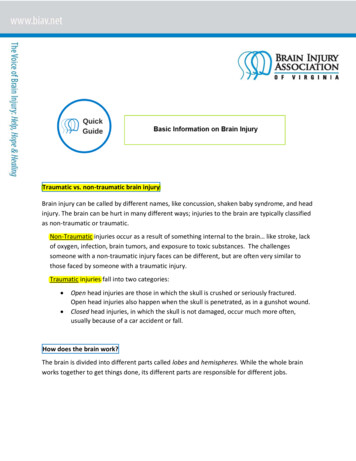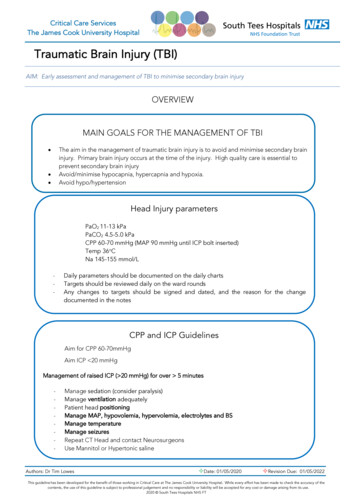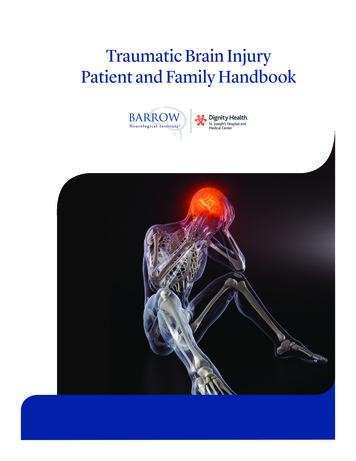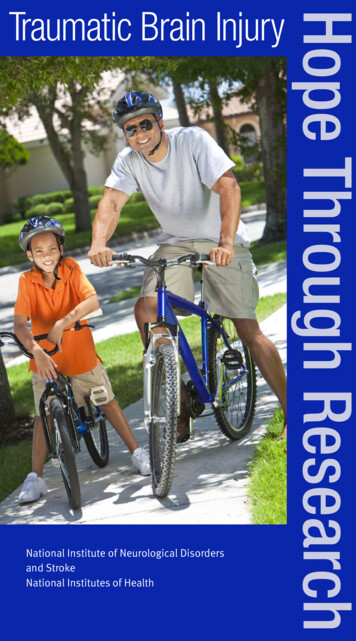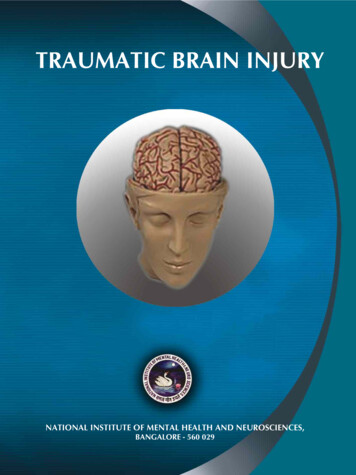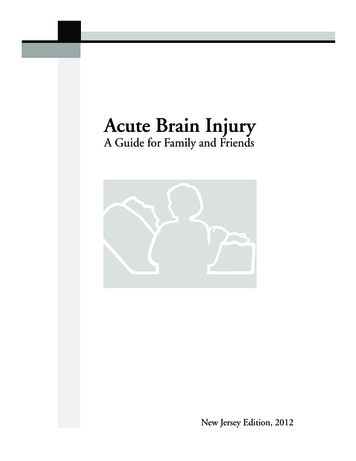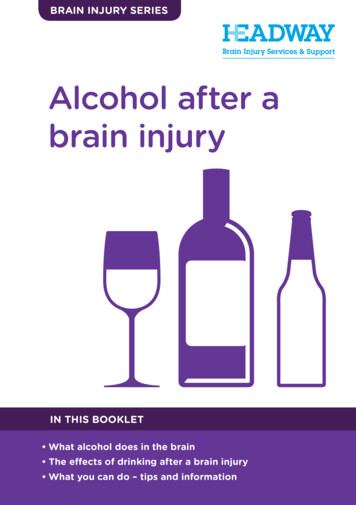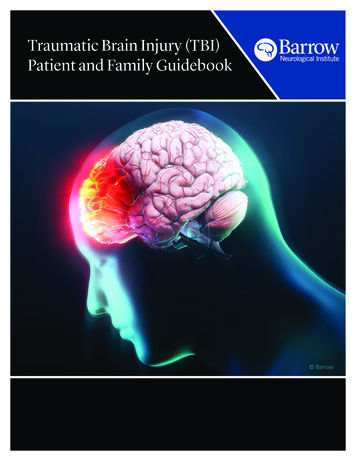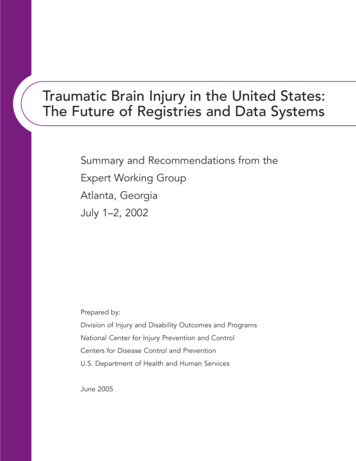
Transcription
Traumatic Brain Injury in the United States:The Future of Registries and Data SystemsSummary and Recommendations from theExpert Working GroupAtlanta, GeorgiaJuly 1–2, 2002Prepared by:Division of Injury and Disability Outcomes and ProgramsNational Center for Injury Prevention and ControlCenters for Disease Control and PreventionU.S. Department of Health and Human ServicesJune 2005
Traumatic Brain Injury in the United States:The Future of Registries and Data SystemsThis report is a publication of the National Center for InjuryPrevention and Control, Centers for Disease Control and Prevention.Centers for Disease Control and PreventionJulie Louise Gerberding, MD, MPHDirectorNational Center for Injury Prevention and ControlIleana Arias, PhDActing DirectorSuggested Citation: Langlois JA, Rutland-Brown W. TraumaticBrain Injury in the United States: The Future of Registries and DataSystems. Atlanta (GA): Centers for Disease Control and Prevention,National Center for Injury Prevention and Control; 2005.
EditorsJean A. Langlois, ScD, MPHDivision of Injury and Disability Outcomes and ProgramsNational Center for Injury Prevention and ControlWesley Rutland-Brown, MPHDivision of Injury and Disability Outcomes and ProgramsNational Center for Injury Prevention and ControlAcknowledgementsThe editors wish to acknowledge the valuable contributions of thefollowing people to the meeting on the Future of Traumatic BrainInjury Registries and Data Systems and to the production of thisreport: Doug Browne, Jacqui Butler, Michelle Huitric, Angela Marr,Jane Mitchko, Teri Ricker, and the staff of the Office of CommunicationResources, National Center for Injury Prevention and Control, CDC.
The reason for collecting, analyzing, anddisseminating information on injuries is tocontrol those injuries and their effects.Collection and analysis should notbe allowed to consume resourcesif action does not follow.— adapted from William H. Foege, Former Director,Centers for Disease Control and Prevention, 1976.
Group ParticipantsChristine BagginiDirector of Family ResourcesBrain Injury Association of VirginiaRichmond, VirginiaAllan BergmanPresident and CEOBrain Injury Association of AmericaMcLean, VirginiaSusan ConnorsExecutive DirectorNational Association of StateHead Injury AdministratorsBethesda, MarylandJohn Corrigan, PhDProfessorDepartment of PhysicalMedicine and RehabilitationOhio State UniversityColumbus, OhioThom DelillaBureau ChiefBrain and Spinal Cord Injury ProgramFlorida Department of HealthDivision of EMS and Community HealthResourcesTallahassee, FloridaLt. Betty HastingsDirectorTraumatic Brain Injury ProgramMaternal and Child Health BureauHealth Resources and Services AdministrationRockville, MarylandJean A. Langlois, ScD, MPH (Moderator)Senior EpidemiologistHealth Outcomes and Disability PreventionDivision of Injury and Disability Outcomesand ProgramsNational Center for Injury Prevention andControlCenters for Disease Control and PreventionAtlanta, GeorgiaDave Murday, PhDAssistant DirectorCenter for Health Services & Policy ResearchUniversity of South CarolinaSchool of Public HealthColumbia, South CarolinaAnne Rohall, EsqDirector of Government RelationsBrain Injury Association of AmericaMcLean, VirginiaPat Sample, PhDAssociate ProfessorDepartment of Occupational TherapyColorado State UniversityFort Collins, ColoradoKaren A. Schwab, PhDStatisticianDefense and Veterans Brain Injury CenterUniformed Services University of theHealth SciencesBethesda, Maryland
Anbesaw W. Selassie, DrPHAssistant ProfessorDepartment of Biometry and EpidemiologyMedical University of South CarolinaCharleston, South CarolinaMary Stuart, ScDChairDepartment of Sociology and AnthropologyUniversity of Maryland, Baltimore CountyBaltimore, MarylandMichael Weinrich, MD, PhDDirectorNational Center for Medical RehabilitationResearchNational Institute for Child Health andDevelopmentNational Institutes of HealthBethesda, Maryland
Table of ContentsExecutive Summary.1Background. 3Registries or SurveillanceBackground. 7What is a Registry?. 7Examples of TBI Registries. 10Working Definition of a Registry.12Other Data Systems.13RecommendationsGeneral. 18Developing a National System of TBI Registries.18Summary. 30References. 31AppendicesAppendix 1: Additional Resources.33Appendix 2: Websites by Topic.34Appendix 3: Other Websites.36
Executive SummaryThis report summarizes the comments, suggestions, and recommendations of a workinggroup convened by the Centers for Disease Control and Prevention (CDC) to discuss thefuture of traumatic brain injury (TBI) registries and data systems. It is intended for policymakers, researchers, advocates, and public health professionals, including those fromstate health departments, interested in furthering the development of systems to collectdata about people with TBI and to help those people learn about available services suchas health care, employment training, and personal assistance.In the Children’s Health Act of 2000, Congress authorized CDC to develop a “NationalProgram of TBI Registries” to collect data about TBI. Currently, CDC supports other TBIdata collection systems, including TBI surveillance, that can also be used to identify peoplewith TBI and help them get information about services.On July 1–2, 2002, CDC convened an expert panel of TBI researchers, advocates, registryadministrators, and other professionals to discuss the future of TBI registries and data systemsand to obtain guidance in the development of a “National Program of TBI Registries.”Meeting participants first reviewed background information about registries and existingCDC-funded TBI and injury data systems, including TBI surveillance. Second, they developeda simple working definition of a TBI registry and described its key functions: Collect TBI data; Identify people who sustained a TBI (maintaining personal identifiers and contact information); Link people with TBI to needed information and services.Third, the panel used this definition as a framework to discuss whether TBI data systems,such as surveillance, might serve the important functions of a registry. Finally, theyrecommended ways that CDC could enhance currently funded TBI data systems to buildTBI registries.1
The expert panel members noted that TBI registries do provide useful information about TBIin some states. However, because of the CDC’s prior work in developing and implementingstandard population-based data collection (surveillance) in most states and the greater costof implementing most registries, they agreed that the expansion of state-based TBI datacollection efforts could best be facilitated by expanding and enhancing existing TBI andinjury surveillance data systems. They also recommended that CDC place a high priorityon developing state-based data systems that can help link people with TBI to neededinformation and services. Meeting participants also recommended a wide range of otheractivities that would enhance TBI research and programs.2
BackgroundThe Future of Traumatic Brain Injury (TBI) Registries and Data SystemsPurpose of the ReportOn July 1–2, 2002, the Centers for Disease Control and Prevention (CDC) convened anexpert working group to discuss “The Future of TBI Registries and Data Systems.” Thisreport documents the group’s comments and suggestions.Meeting Goals and ObjectivesCDC convened the meeting to obtain guidance in responding to new language in theChildren’s Health Act of 2000, which charged the agency with developing a “NationalProgram of TBI Registries.” (See text box, pg. 6, for details about legislation authorizingCDC’s TBI activities.)There were several objectives for the meeting: Develop an operational definition for the term registry; Discuss how CDC’s current TBI data collection activities might serve as the basisfor developing a new registry; Recommend future CDC activities.Meeting Participants and ProcessThe 13 participants included TBI researchers, advocates, registry directors, andrepresentatives from state and federal government agencies. With input from theBrain Injury Association of America (BIAA), the National Association of State HeadInjury Administrators (NASHIA), and the National Institutes of Health (NIH), CDCselected invitees based on their experience and potential to contribute to a greaterunderstanding of the need for TBI data systems, such as registries, and the bestapproaches to developing state-based data systems. At the time of the meeting,two participants were involved in managing state-based TBI registries in Floridaand Virginia; one participant was the principal investigator for both a CDC-fundedstatewide TBI surveillance system and a TBI follow-up registry in South Carolina.3
For the first two objectives, CDC staff prepared background material for discussion, includinga draft definition of a registry and an overview of CDC’s current TBI data collection activities.The meeting began with an overview of this material, followed by presentations by meetingparticipants who were directly involved in managing TBI registries or surveillance systems.These participants presented information about their programs and answered questions.For the remainder of the first day, participants discussed the information from the backgroundpresentations. A professional note taker recorded participants’ comments and suggestions.On the second day, the moderator presented a synthesis of the suggestions for review andrevision by the participants.This report documents the final summary of comments and recommendations by workinggroup members. For some sections, more detailed information, references, and othermaterials have been added to clarify and update the information presented at the meeting.Readers of this report should also consult the companion website, Traumatic Brain InjuryData Collection at www.cdc.gov/ncipc/profiles/tbi. This site provides detailed informationabout state-based TBI data systems, including those discussed at the expert meeting.Summary of PresentationsCDC staff and selected meeting participants presented the following background information:The Need for TBI Data Systems or “Registries”According to national statistics, more than one million people in the United States survive atraumatic brain injury each year, and at least 80,000 of them experience long-term disabilityas a result of their injuries (Thurman et al. 1999).4
Before states can adequately respond to this important public health problem, each statemust determine the number and characteristics of people affected, categorized by age,sex, race, etc. Registries in Florida and Virginia, for example, have proven useful for thispurpose; many other states have successfully used various other approaches to collectinginformation about people with TBI. Regardless of the approach, advocates, policy makers,and TBI service providers agree that TBI data must be specific to each state to effectivelyinform primary prevention activities, policy development, and planning to ensure adequateservices for people with TBI.The Children’s Health Act: CDC’s Charge to Develop TBI RegistriesEach state needs TBI information about its residents. Recognizing this need, Congress, inthe Children’s Health Act of 2000, authorized CDC to develop a “National Program of TBIRegistries.” The objective is for CDC to “make grants to states to operate the state’straumatic brain injury registry.to collect [TBI] data. about the demographics and clinicalcharacteristics of persons hospitalized with TBI.” (See text box, pg. 6, for details aboutlegislation authorizing CDC’s TBI activities.)5
Legislation Authorizing CDC’s TBI ActivitiesThe TBI Act of 1996 (PL 104-166)In 1996, the U.S. Congress passed Public Law 104-166, the Traumatic Brain Injury Act.This Act required CDC to: Further develop uniform TBI reporting systems among states; Submit a report to Congress about TBI incidence and prevalence(National Center for Injury Prevention and Control 1999b).(For actual language, go to t the range 104-151 to 104-200 and click search. Scroll down to 166. Select text or pdf.)The Children’s Health Act of 2000 (HR 4365)In 2000, Congress passed TBI Act amendments which required CDC to: Disseminate national information on the incidence and prevalence of TBI. Provide information in primary care settings concerning the availabilityof state-level services. Develop a national education and awareness campaign. Develop a National Program for TBI Registries. Make grants to states for operatingthe state’s traumatic brain injury registry and collect data such as the following: Demographic information; Circumstances of injury; Source of the information, dates of hospitalization and treatment, date of injury; Information characterizing clinical aspects of the injury, including types oftreatment and services used.(For actual language, look at Title XIII – Traumatic Brain Injury 4365:. Select text or pdf.)6
Registries or Surveillance?Considerations in Implementing the Children’s Health ActBackgroundRegistries do provide useful data about TBI in some states. However, several factors shouldbe considered in determining the best approach to developing a national program of TBIregistries. First, as of January 2005, CDC supports injury data collection systems in more than30 states, including TBI surveillance in 11 of these states. Second, although the need fornational data on the impact of TBI in the United States is often used to support the need fora national registry system, CDC has routinely and successfully used existing national data setsmaintained by the National Center for Health Statistics to meet that need (Thurman et al.1999). Third, although not specifically stated in the authorizing language, CDC supports theidea that where possible, TBI data systems should also provide information about the out comes and service needs of people with TBI and link those individuals to needed services,such as personal assistant services, transportation, or help finding employment. TBI serviceagency staff, advocates, and other professionals also support this view. Finally, in addition toduplicating other data collection efforts, the development of a program of registries separatefrom current CDC data collection efforts could be very costly. CDC is charged with conduct ing a wide range of other TBI-related activities with limited funding totaling approximately 5.7 million in FY 2005.What Is a Registry?General DefinitionA registry can be defined as “a collection of data about a particular group of people whoshare a common personal characteristic, for example development of the same disease ”(Feinstein 1998, p.475). However, there is wide variation in the type and nature of registries,which can range from a simple list of people affected by a disease or condition, to a complexsystem of identifying, contacting, and providing case coordination to help people with thecondition get the services they need.7
Characteristics and Functions of a TBI RegistryThe expert panel members discussed the following background information about registryfunctions and funding mechanisms. Data collectionTBI registries vary in the type and completeness of the data collected. Collectingdata about people who experience a TBI is the most basic function of a registry.TBI registries typically collect information about demographics (e.g., age, sex, race),clinical characteristics (e.g., the type and severity of the injury to the brain), and theexternal cause of the injury (e.g., fall, motor vehicle crash). Data about other factorsthat can influence recovery (e.g., the presence of other health conditions) aresometimes collected. IdentificationA key feature of a registry is legal authority to identify people with the conditionand maintain and use their personal identifying information to contact them.Contact is usually initiated to request their enrollment in research studies or toprovide them with helpful information about available services. TBI registriestypically identify patients soon after they are admitted for medical care.The registries usually require specialized staff to review medical records and eitherenter the data into a special data system or forward the data to another location formanagement. This allows for early identification of people with the condition, easeof tracking them over time because accurate contact information is obtained, andflexibility in the amount and type of data collected. However, unless extensiveresources and rigorous methods are applied, the reporting of cases is oftenincomplete. Such a registry can also be costly. For example, CDC providesabout 35 million per year to fund operation of state cancer registries (personalcommunication: P.M. Talboy, CDC, 2002). Each state also contributes fundingto support this activity. (See the CDC National Program of Cancer Registrieswebsite: www.cdc.gov/cancer/npcr.)8
Linkage to servicesHelping link people with TBI to services is an important function of a TBI registry,according to experts in the field (National Center for Injury Prevention and Control1999a). Assistance in obtaining services is particularly important for people with TBIbecause cognitive problems resulting from their injury make it difficult for them tofind and access the services they need to compensate for these problems (GeneralAccounting Office 1998). Follow-up data collectionContacting and interviewing people with TBI to find out about the nature andextent of the problems they experience as a result of their injury can help increaseknowledge about the factors that influence recovery and the services these peopleneed. TBI often results in long-term disability that interferes with performance ofroutine daily tasks, return to work or school, and successful community reintegration(National Institutes of Health 1999). Quantifying these problems can provideinformation needed by state agencies to plan for and justify funding for the servicesthat residents with TBI need. FundingMost TBI registries currently rely heavily on state funding dedicated to supportingthe registry, including some that receive funding from trust funds, for example fromfines for driving under the influence.9
Examples of TBI RegistriesThe following is a brief summary of basic information about selected TBI registries.StatesThe Florida Brain and Spinal Cord Injury Program (FBSCIP) supports a TBI and Spinal CordInjury (SCI) registry that identifies moderately to severely injured people with TBI whilethey are still in the hospital. The program focuses on case management to facilitatecoordination and payment for rehabilitation services needed for their return to thecommunity. Florida residents with mild TBI also have access to assistance throughcontractual services with the Brain Injury Association of Florida and special projects(personal communication: K. Shields, FBSCIP, June 2004). The staff of the Florida registryindicated that all people hospitalized for moderate to severe TBI are routinely reportedto the registry (personal communication: T. DeLilla, FBSCIP, July 2002). (See the FloridaBrain and Spinal Cord Injury Program website: www.doh.state.fl.us/Workforce/BrainSC.)Virginia operates a TBI/SCI registry in which hospitals report information about new casesof TBI/SCI to a centralized data center at discharge (personal communication: C. Baggini,Brain Injury Association of Virginia, July 2002). Individuals of all ages who are treated formild, moderate, or severe injuries, including those treated and released from a hospitalemergency department, are expected to be reported to the registry. Outreach material issent to those who are reported, and subsequent information and referral services areprovided to those who request them. Not all hospitals report all cases to the Virginiaregistry (personal communication: C. Baggini, Brain Injury Association of Virginia, July 2002).Although reporting to the Virginia Central Registry for Brain Injury and Spinal Cord Injuryis mandated by the Code of Virginia, there are no sanctions available to ensure compliance.This is a common problem for registries that cannot enforce hospital reporting and for whichfunding is limited. (See the Virginia Central Registry website: www.biav.net/central registry.htm.)10
The exact costs of operating registries are difficult to calculate because various tasks maybe performed by different agencies, facilities, or personnel. The Florida TBI registry relies onfunding from the Brain and Spinal Cord Injury Rehabilitation Trust Fund. Florida estimates thecost of TBI data collection only (excluding case coordination and other registry functions) at 75,000 per year. The Virginia registry is supported by state funding. Virginia’s costs for TBIdata collection only are reported to be approximately 125,000 per year.MilitaryThe Defense and Veterans Brain Injury Center (DVBIC) supports a registry and trackingsystem that identifies and follows consenting military personnel and veterans who werediagnosed with and treated for a TBI. Clinicians in designated facilities, including threemilitary medical centers, four veterans’ affairs medical facilities, and one civilian communityreentry facility, are asked to report all people hospitalized with a TBI to a central registry.Medical centers also collect information about patients treated and released fromemergency departments and outpatient clinics. An important function of the registryis to help people with TBI obtain appropriate services, receive follow-up clinical contacts,and receive appropriate educational materials. (For more detail see: www.dvbic.org.)11
Working Definition of a Registry: Key Registry FunctionsBased on the information presented previously, the expert panel concluded that the workingdefinition for a TBI registry should include the following primary functions (also shown in Figure 1): Data collection; Identification (maintaining personal identifiers and contact information),considered a key function that distinguishes a registry; Linking people to services (helping them get information about available services).Figure 1. Model for Building TBI RegistriesLinking People to ServicesIdentification(Personal identifiers and contact)Data Collection(Surveillance)Figure 1 illustrates the potential for registry systems to be built on existing TBI datacollection systems (shown at the base of the figure) by adding to the basic datacollection function the functions of identification and linking people to services.Three secondary functions were considered: Data linkage: Linking registry information to data from other sources, such asMedicaid claims data, in order to track the use of social services and related costs.Including in the data system personal identifiers such as social security numberscan facilitate such linkages. Follow-up data collection: Contacting people who have had a TBI and interviewingthem to find out about health and other problems they may be experiencing. Evaluation: Evaluating whether people with TBI who were linked to services weresatisfied with the services and benefited from them.12
Other Data SystemsIn addition to the registries described previously, other state-based data systems have provenuseful or shown the potential to provide needed information about TBI. The primary sourcesof state-based TBI data are described below.TBI SurveillanceTBI surveillance is the most promising data system that could be enhanced to serve thefunctions of a TBI registry. For that reason, the description of surveillance by registry function(below) is more detailed than that of the other data system mentioned. Additional informationabout TBI surveillance is available in the article “Traumatic Brain Injury-Related HospitalDischarges” (Langlois et al. 2003), from this report’s companion website about TBI datasystems (see data systems website: www.cdc.gov/ncipc/profiles/TBI), and in theCDC Annual CNSI Data Submission Standards (Marr and Coronado 2004). Data collectionDefinition and description of TBI SurveillanceSurveillance is defined as routine, ongoing collection of data about people whosustained a TBI. States that conduct TBI surveillance process and analyze TBI dataobtained primarily from statewide mortality data sets and existing administrativedata sets, including statewide hospital discharge data sets that were originallydeveloped for billing purposes. Thus, TBI surveillance differs from most registriesbecause it does not require a dedicated hospital-based system for collecting dataabout people hospitalized with TBI. As a result, surveillance also has the advantageof being low cost in relation to the completeness of case ascertainment and thequality and extent of the data obtained. As of January 2005, CDC funded 11states to conduct TBI surveillance. Each state received 80,000 per year to processbasic data about the number and demographics of people hospitalized with TBI intheir state. Six of these states also received 65,000 to abstract additionalinformation from medical records.13
TBI registries and surveillance vary in the extent to which they capture all casesof TBI that occur within a state. Despite some limitations in case identification,CDC-funded TBI surveillance tends to have more complete case identificationthan TBI registries because surveillance data are routinely collected for billingpurposes. Thus, surveillance data are described as population-based; that is,these data include all or nearly all of the hospitalized TBI cases in a geographicallydefined area (or state), allowing for an accurate assessment of the impact of TBI inthat area. Ideally, TBI registries should also be population-based. However, evenwith state mandates, many registries underreport TBI cases. (See text box, pg. 17,for additional information about population-based data systems.)Limitations of data collection using TBI surveillance TimelinessTBI surveillance states vary in the amount of time required to obtain theadministrative data sets. The average time is currently 12 to 18 months afterthe close of the calendar year. FlexibilityBecause most states use existing administrative data sets, the information that canbe collected is limited to what is already routinely collected. Some state surveillancesystems abstract additional information from hospital records, but that information islimited to what is recorded. Completeness of case ascertainmentAlthough considered to be population-based, the TBI surveillance system does notcapture “all” cases. For example, because most state surveillance systems funded byCDC collect only data on deaths and hospitalizations, people with TBI who are notadmitted to a hospital are not included.14
Even states that collect data on people who are treated and released from theED will miss those who do not seek and receive medical care or who are seenby private doctors.State-based hospital discharge data systems frequently miss people treated inprison hospitals, military and veterans’ hospitals, Indian Health Service hospitals,or hospitals in another state. However, these omissions typically result in a relativelysmall percentage of hospitalized cases that are not identified. Availability of dataStates vary in the kind and amount of TBI data that are available. Some state datasystems have missing cause of injury codes (E codes) for a large proportion of data;E codes describe, for example, whether an injury resulted from a fall or motorvehicle crash. IdentificationSome states with TBI surveillance have legal authority to identify and contact people withTBI that reside within the state. This allows states to collect and keep information such asnames and addresses within the surveillance data set for collecting follow-up data orlinking them to services. Linkage to servicesTBI surveillance systems in states with legal authority to identify and contact people withTBI can serve an important role in linking state residents with TBI to information aboutavailable services. With CDC funding, the Colorado Department of Health and theEnvironment, in collaboration with the Colorado State University, the Brain InjuryAssociation of Colorado, and the Colorado HRSA-funded TBI services project, investigatedwhether surveillance system data could be used to help link people with TBI to services.Using their legal authority, the Colorado TBI Surveillance Program identified from thesurveillance system a sample of people hospitalized with TBI.15
Project staff then sent them letters about a new 800 number with information aboutavailable services. This effort resulted in a fourfold increase in the number of calls to thatnumber (personal communication: P. Sample, Colorado State University, 2002).These efforts demonstrate the potential for TBI surveillance to be used to help peoplewith TBI find out about and access needed services. As of January 2005, an evaluation ofthe effectiveness of the 800-number project to find out whether people with TBI whocalled the number actually got the services they needed
National Center for Injury Prevention and Control . Ileana Arias, PhD Acting Director. Suggested Citation: Langlois JA, Rutland-Brown W. Traumatic Brain Injury in the United States: The Future of Registries and Data Systems. Atlanta (GA): Centers for Disease Control and Prevention, National Center for Injury Prevention and Control; 2005.


